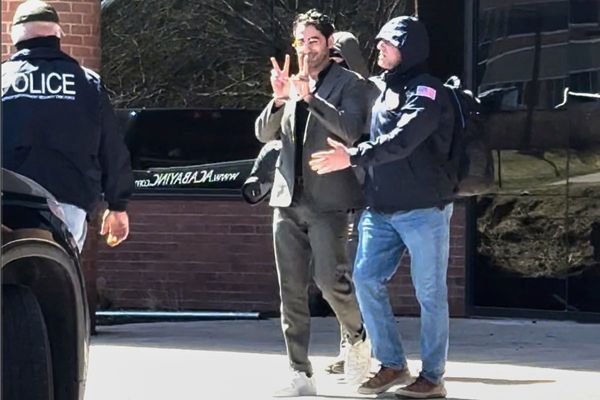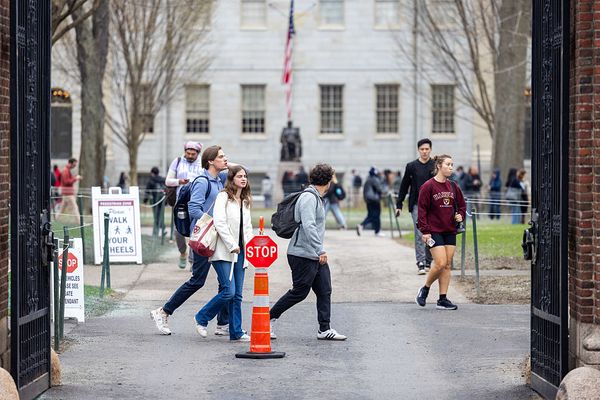
This season didn’t begin for the Minnesota Vikings in September. It began in January.
Last January. At a children’s playdate.
Brian Flores’s daughter, Liliana, had friends over to their home. Their father? Mike Sherels, a former longtime linebackers coach with the University of Minnesota.
While watching the kids, Sherels talked of the many NFL linebackers he worked with including Damien Wilson and DeVondre Campbell. However, Sherels felt the best of them was Blake Cashman, who starred for the Golden Gophers and made second-team All-Big Ten in 2018.
Sherels also mentioned that Cashman was hitting free agency after a breakout 2023 campaign with the Houston Texans in which he recorded 106 total tackles, nine tackles for loss, five quarterback hits, two sacks and a fumble recovery.
The conversation prompted Flores to look at his film after not previously having been familiar with his game. After review, Flores pounded the table for the Minnesota native prior to free agency, who eventually signed with his hometown team on a three-year, $22.5 million contract.
Cashman’s deal was officially agreed upon on March 13, the same day Minnesota also signed quarterback Sam Darnold, running back Aaron Jones, outside linebackers Andrew Van Ginkel and Jonathan Greenard, and Cashman on the inside.
The result is one of the most impactful free-agent classes for any team in recent memory, the product of a three-year plan by coach Kevin O’Connell and general manager Kwesi Adofo-Mensah, centered around clearing long-term cap space while still competing in the moment.

After finishing 7–10 and out of the playoffs in 2023, the Vikings were prepared to embark on a new direction. Quarterback Kirk Cousins was 35 years old and coming off a torn Achilles. The defense was improving but not yet in the image of Flores, a veteran defensive coordinator who was searching for more versatility and athleticism.
And while the offense got a new quarterback in Darnold, it’s the defense which underwent a massive facelift.
In Minnesota, the conversations about whom to target in free agency are a group effort led by Adofo-Mensah, his leadership team, along with Director of Pro Personnel Sam DeLuca and Executive Vice President Rob Brzezinski. Typically, the Vikings’ front office comes up with 10 top targets and whittles the list to three. The same list is also given to the coaching staff, which ranks its top three.
Once the targets are established, Brzezinski begins working on the quantitative analysis, figuring out a player’s value while Adofo-Mensah speaks with the representatives on their contractual ask.
This winter, Cashman, Van Ginkel and Greenard were key targets along with Zack Baun, who ended up signing with the Philadelphia Eagles and flourishing under coordinator Vic Fangio. Another target who landed in Philadelphia? Saquon Barkley.
Leaving the scouting combine a week before the NFL’s legal tampering period began, Minnesota felt good about its position. Then, on March 11, teams were allowed to make calls. The Vikings made plenty, quickly becoming one of the league’s most active teams.
Ultimately, they landed Van Ginkel on a two-year, $20 million deal, a longtime favorite of Flores after the two spent three years together (2019 to ’21) with the Miami Dolphins. For the former Dolphins head coach, nobody was more key to sign this past winter.
“It’s hard on film to know how smart a guy is and whether or not he can make this check and that check,” Flores says. “Me having spent a lot of time with him, there’s some things you can’t really measure or see statistically that I knew he’d be able to bring to the table. Thankfully, they trusted me enough to bring him on. He allows us to be flexible on defense.”
The Vikings also agreed with Cashman before getting into a battle to sign his former Texans teammate in Greenard, ultimately wrestling him away in a bidding war from Adofo-Mensah’s old team, the Cleveland Browns, on a $76 million deal over four years.
After playing out his rookie deal with Houston, Greenard left for both a significant change but also the comfort of familiarity.
“I was in a similar scheme when I was at Florida and Louisville,” Greenard says of Flores’s defense. “I played the same exact position, so it’s pretty much the same plays as well, just different terminologies and stuff. But there are little small, different kinks in there as far as coverages. But I pretty much just dialed it back to that point, went back to my old playbooks, talked to my old coach and stuff like that, and understood what my opportunities would be.”
Although All-Pro defensive end Danielle Hunter was lost to the Texans in free agency, the Vikings had suddenly added three key pieces to their front seven, giving them the flexibility and versatility required to play Flores’s varied scheme.
Days later, two more cogs were acquired in edge rusher Jihad Ward on a one-year, $1.7 million deal and corner Shaquill Griffin for one year and $4.4 million.
Factoring in the deals for Darnold and Jones, and the eventual August contract for corner Stephon Gilmore, Minnesota had signed those eight players for a grand total of $148.6 million, including $90.6 million guaranteed. Those numbers are $31.4 million and $9.4 million less, respectively, than Cousins’s deal with the Atlanta Falcons alone.
It was the ultimate bet by one of the league’s most forward-thinking front offices, led by a former day trader on Wall Street with a master’s degree in economics from Stanford.

With the personnel he desired, Flores’s defense has flourished.
Perhaps most impressive of all, the Vikings have consistently stolen the ball. In the regular season, they were the only team to record at least one takeaway in every game, registering an NFL-best 33. Minnesota was also fantastic on fourth down, topping the league at 37.1% conversion rate against on 35 attempts.
“It’s one thing to play good defense, which they have,” Vikings coach Kevin O’Connell says. “It’s one thing to stop the run, which they have. … But when you are able to take the football away in every single game, that’s not even including the fourth-down stops, which I think our numbers in that department have been really good as well. Those are momentum plays for your entire team. It’s not just getting off the field on third down and then a punt play flips field position. It’s field-position plays, it’s momentum plays, it’s stopping the momentum of another team and giving yourself a chance to win.
“[Fourth-down stops] are such critical field-position plays anyway, and especially with where our game is going. … It’s almost one of those things now when you’re surprised when people don’t go for it and there’s a lot of circumstances with each team, each team’s belief and philosophy on fourth down or points, or field position. A lot of those things still exist. They still have a huge impact on winning football games. When I look at, it’s definitely something that, for sure, is a turnover and it’s not just the ones at the goal line where it’s fourth-and-one at the 1.”
This year, the Vikings are also third in quarterback knockdowns, fifth in pressure rate, fourth in QB hits, third in tackles for loss, fourth in sacks and third-best in missed tackles. Still, despite the aggressiveness, Minnesota is fourth with 4.1 YPC against.
“I’ve kind of been preaching how smart this unit is,” Cashman says. “We all have a great understanding of the scheme and the details within it. And as the season has developed, you start to build chemistry with each other on who does what well and simply playing off guys in front of you. We always look for ways to improve because we’ve been really good at times, but we think we can be elite and unstoppable.”
In 2023, Greenard and Van Ginkel were great pass rushers who somewhat flew under the radar. The former ranked sixth in ESPN’s pass rush win rate metric, while Van Ginkel was 20th.
This year, Greenard is ninth and seventh against the run for all edge rushers. Van Ginkel is having a season worthy of Defensive Player of the Year talk, racking up 11.5 sacks, 18 tackles for loss and 19 quarterback hits, ranking fourth and third, respectively, in the first two categories league-wide. As a team, Minnesota ranks third in pass rush win rate and fourth against the run.
“We got an ascending player who had a good year last year, but his best football is in front of him still,” Flores says of Greenard. “He’s smart, he has leadership, I think he’s talented. This defense is different from the one he was in in Houston. It’s a little bit more of a true outside linebacker where there’s some drops and things from that standpoint. I think his willingness to do those things and learn and grow as a player has been great this year. He loves to play, man.”
Then there’s Ward, who despite only having one sack as a rotational pass rusher, has churned out an impressive 14 quarterback hits while playing just 41% of Minnesota’s defensive snaps.
As for Cashman, he’s having a career year under Flores. The previously oft-injured linebacker has played 14 games and totaled 112 tackles, 11 quarterback hits and 4.5 sacks while providing excellent coverage, with eight passes defensed.
“He’s smart, he’s tough,” Flores says. “I think he loves to play. I think he wants to be great. I think he wants to be a great teammate. He’s unselfish. I love having him around; he’s been great. He makes plays.”
In Flores’s world, the defense is an empowered group, starting with having a strong communication hub which includes safeties Harrison Smith and Josh Metellus along with Van Ginkel, Greenard and Cashman.
The veterans have taken on a shared leadership role in one of the league’s more complex schemes with a dizzying array of coverage calls and blitz packages. Whereas most teams look to disguise presnap, the Vikings are one of the busiest postsnap teams, often rotating on the back end or shifting up front after the ball is put in play.
It’s why, as Cashman noted, the defenders in Minnesota can’t just be athletic and versatile. They also have to be smart. And in the case of Flores, they must be trusted and given the freedom to trust their own intellect.
“It’s guys that have played a lot of football,” Van Ginkel says. “Just the knowledge and instincts that we have, being able to see something out there on the field, how they’re trying to attack us. We bring it to [Flores] if we see something one way, just let him know. [Flores] likes to say it’s our defense. He likes to give us the keys. He allows us to go out there and make certain calls in certain situations that best fits.”
For Flores, who credits Bill Belichick as his biggest influence but also studies the film of fellow defensive gurus such as Dick LeBeau, Todd Bowles, Mike Zimmer, Rex Ryan and Steve Spagnuolo, controlled aggression is the key. In this free-agent class, combined with some of the aforementioned holdovers from years past, Flores has found the right mix.
A year ago, Minnesota blitzed an incredible 51.5% of the time, according to Pro Football Reference. That’s the highest rate of any team since the 2019 Baltimore Ravens, who brought extra pressure on 54.9% of snaps. This year, while Minnesota’s blitz rate is still first in the league, the percentage has plummeted to 38.9%, showcasing an increased ability to get home with just four rushers.
Flores, long known for his blitz-happy ways (in Miami, his defenses were 11th, second and second in blitz rate), will tell you he prefers to get to the quarterback with three or four when possible. In the past, that perhaps wasn’t a viable option. Now that it is, the calls are changing some. The philosophy, however, is not.
“You don’t want to be passive,” Flores says. “You don’t want to sit back and wait for the offense to make a mistake. There are a lot of systems where they don’t believe an offense can put together 15-play drives over and over again. They’ll make a mistake. … I’m a believer the offense is going to execute and if we don’t try to create some type of pressure, whether it’s with a disguise or blitzes, they’re going to find a completion, find some run lane. That’s just a belief of mine.”
On Monday night, the Vikings will face the Los Angeles Rams in the final game of wild-card weekend. If they’re going to advance and earn their first postseason win since 2019, it’ll likely be because the defense limited an offense featuring Matthew Stafford, Puka Nacua, Cooper Kupp and Kyren Williams.
“When you can come to work everyday and you have someone like [Kevin O’Connell] leading your team, just the joy and excitement that he brings, it’s special. It’s a special group to be part of.”Andrew Van Ginkel
In 17 games, the defense has come together, blending its new characters with the mainstays. For the Vikings, the goal is now to play four more contests, culminating in New Orleans with Super Bowl LIX.
For all, the goal is undoubtedly to win a title, something Minnesota hasn’t accomplished in its 64-year existence. For some, advancing is also about continuing to revel in a season that was largely unexpected on the outside, and thoroughly enjoyed within.
“Guys that are in this locker room, there’s a lot of selfless guys,” Van Ginkel says. “Guys that care and love football. When you have a group of guys like that that come together and are trying to build something special, we have a great organization that continues to build us up. When you can come to work everyday and you have someone like [Kevin O’Connell] leading your team, just the joy and excitement that he brings, it’s special. It’s a special group to be part of.”
The Vikings’ season began on the field in September, but the vision started coming together for this team in January.
Twelve months later, it has all led to the postseason, and a defense capable of making a deep run within it.
More NFL on Sports Illustrated
This article was originally published on www.si.com as How the Vikings Cashed In With Defensive Free Agents.







